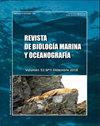Thermal preference and tolerance of Peruvian grunt Anisotremus scapularis juveniles (Pisces: Haemulidae), Preferencia y tolerancia térmica de juveniles de chita Anisotremus scapularis (Pisces: Haemulidae)
IF 0.5
4区 生物学
Q4 MARINE & FRESHWATER BIOLOGY
引用次数: 1
Abstract
Thermal preference and tolerance of juvenile Anisotremus scapularis (Pisces: Haemulidae) at different acclimation temperatures (14, 17 and 22°C) were evaluated in order to estimate the optimum temperature and the thermal tolerance limits of this species. The preference was determined through acute preferred temperature. Maximum critical temperature and mean lethal temperature allowed to estimate thermal tolerance. The results show that acclimation temperatures higher than 14°C increase both thermal preference and tolerance. However, individuals acclimatized to 22°C preferred temperatures lower than their acclimation. In addition, thermal tolerance was identical between individuals acclimatized at 17°C and 22°C. The optimum temperature of juvenile A. scapularis was 18.7 ± 2°C and its upper and lower tolerance limit was 32.6 and 10.1°C, respectively. Based on the results, we concluded that a temperature of 18.7 ± 2°C would optimize the physiological processes in juvenile A. scapularis and that temperature higher than 32.6°C and lower than 10.1°C would cause the immediate death of the organism.秘鲁石首鱼肩胛骨幼体的热偏好和耐受性(双鱼:嗜血动物科),肩胛骨石首鱼幼体的热喜好和耐受性
为了估计该物种的最适温度和耐热极限,对幼年肩胛Anisotremus肩胛骨(双鱼:嗜血动物科)在不同驯化温度(14、17和22°C)下的热偏好和耐热性进行了评估。通过急性优选温度来确定偏好。允许估计热耐受性的最高临界温度和平均致死温度。结果表明,高于14°C的驯化温度提高了热偏好和耐受性。然而,适应22°C的个体更喜欢低于其适应温度的温度。此外,在17°C和22°C下驯化的个体之间的耐热性是相同的。幼年肩胛骨蛙的最适温度为18.7±2°C,其耐受上限和耐受下限分别为32.6和10.1°C。基于这些结果,我们得出结论,18.7±2°C的温度将优化幼年肩胛骨a.的生理过程,高于32.6°C和低于10.1°C的气温将导致该生物立即死亡。
本文章由计算机程序翻译,如有差异,请以英文原文为准。
求助全文
约1分钟内获得全文
求助全文
来源期刊
CiteScore
0.70
自引率
0.00%
发文量
41
审稿时长
12 months
期刊介绍:
Publicar desde una perspectiva científica, artículos originales, decididos por un proceso de revisión por pares, invitando a expertos de reconocido prestigio en el área. Los trabajos publicados se caracterizarán por su solidez teórica-metodológica, actualidad y relevancia para las ciencias marinas.
Se reciben trabajos inéditos derivados de la investigación científica realizada en ambientes marinos y estuarios, en formato de Revisión, Artículos, Notas Científicas, y Obituarios en las siguientes disciplinas::
Biología-Ecología marina
Oceanografía física, química y biológica
Contaminación marina
Geología marina
Sistemática, Faunística y Biogeografía Marina
Manejo Costero
Acuicultura marina
Pesquería marina.

 求助内容:
求助内容: 应助结果提醒方式:
应助结果提醒方式:


